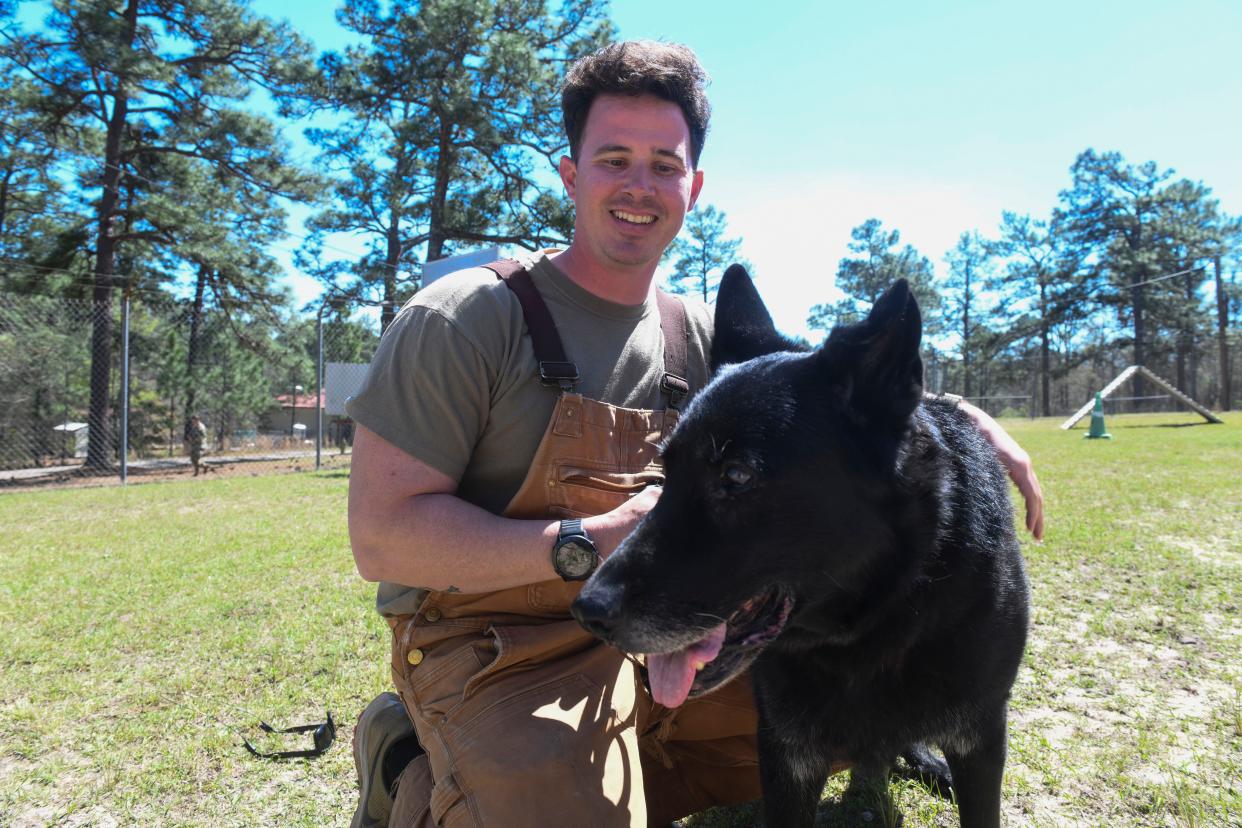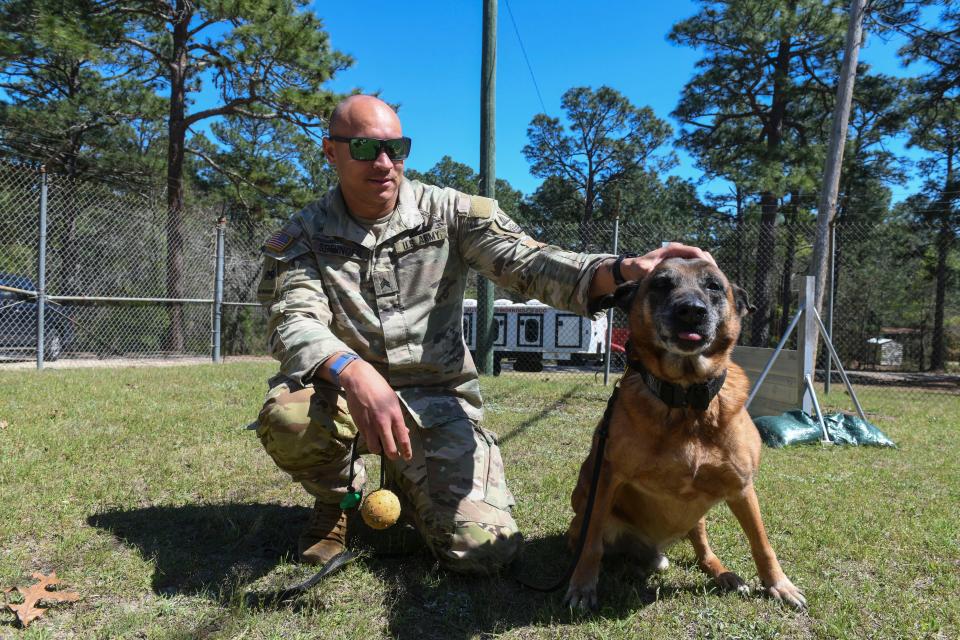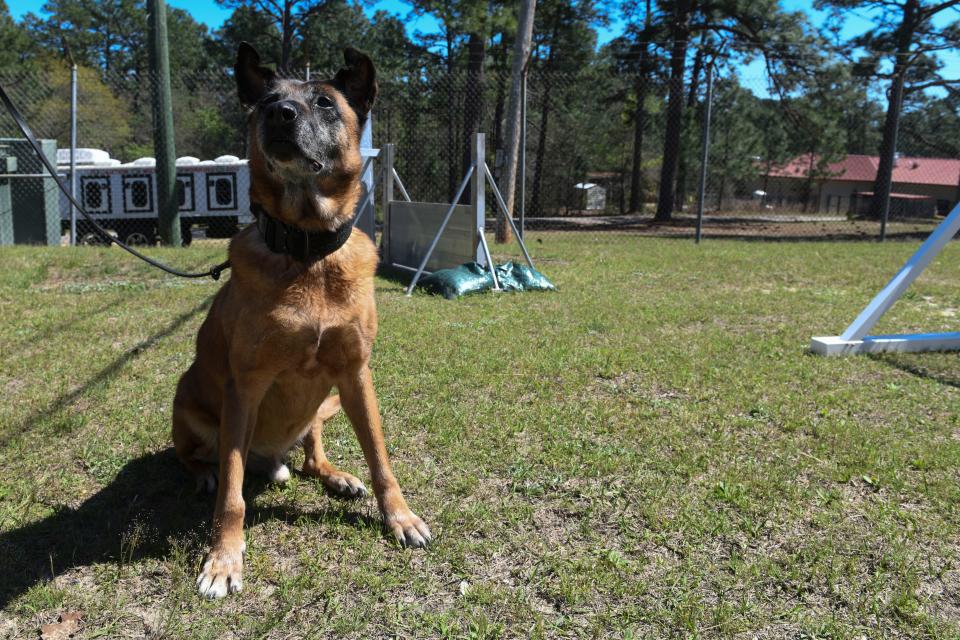'We went through a whole lot together:' Fort Eisenhower soldiers adopt K9s after deploying

Fort Eisenhower is home to many military K9s and their handlers, but two local handlers took the extra step to adopt their now-retired K9s after serving with them overseas.
Sergeant Robert Emfinger joined the Army in 2009 and was in artillery until 2016. After working with K9s in Afghanistan, he developed a new interest in the field. When he went to re-enlist, he reclassed to 31 Kilo - the "Working Dog Handler" MOS.
"I made it through the 31 Kilo training and went to Fort Bragg, North Carolina for six years," Emfinger said. "That's where I was teamed with Jager, my [now] retired dog."
Having been deployed both with and without a K9, Emfinger said there are differences in what those deployments look like.
"The one with the dog, you're more occupied because you have a dog that needs training," he said. "You can't just put them away and expect them to perform at the same level without advancement training every day. I think you're more active with the dog – you're actually training and then running missions. You're doing a lot more than you would on a regular deployment."
Emfinger added having a dog along on the deployment can give a sense of comfort.
"I guess it gives you the comfortable feeling that the dog is on the ground searching for stuff we can't find or visually see," he said. "I would say there is also a comfort level for everybody else seeing the dog out there."
Jager, a German Shepherd who worked in the military for 10 years, is now retired at 14.
"I have seen PTSD in some dogs, mostly from the explosions and stuff that has happened while they're on the deployment," Emfinger said. "Some dogs come back and we have to run through a gunfire training, and that dog just can't handle it anymore. With the loud noise, the dog will get aggressive toward the handler or toward the gunfire. But for my dog [Jager], we didn't really have an experience like that and he really has no sign of PTSD. He's really chill."
He said since Jager's retirement, he has become a lot more relaxed and easygoing.
"If he was on leash and we were together, nobody could approach us because he was protective of me and he would start showing his teeth and growling toward other individuals that just walked up," Emfinger said. "Now that he's retired, he's just a couch potato. He loves getting pets and loves kids. He's a totally different dog now ... The only thing that didn't break from him was his feeding times. You still have to feed him at the same time as he ate when he worked, or he will wake you up to do that."

Sergeant Alijah Springer, another Fort Eisenhower handler who adopted his K9 after retirement, said he saw a few signs of PTSD and similar behavioral changes with his dog, Alec.
"Alec doesn't like getting put into cars anymore," Springer said. "If there's a loud bang or fireworks, he tends to go hide ... The biggest [behavioral] difference is when I was working him, he hated to be around kids. He was always trying to snap at kids and didn't want to be touched. But since I've had my kids and Alec, Alec cares more about the kids than me."
Springer joined the military in 2016 and signed for the 31 Kilo contract. He was paired with Alec during his last three years at Fort Leonard Wood.
When it came to deciding if he was going to take Alec after his retirement, he said there wasn't any hesitation.
"For me and Alec, we went through a whole lot of stuff together," Springer said. "Toward the end, when I started separating myself from work because I was getting ready to leave, Alec started having these weird tendencies like chewing on himself and he wouldn't eat for other people. At that point, it was only fair that I took him because I was the only one he really wanted to eat for, not show out for, and just relax with."
Emfinger shared the same sentiment.
"Me and Jager did a lot of secret service missions together, we deployed together, and I was his last handler for the six years that he worked," he said. "I thought it was fair to him that if I was able to take him home, I was going to take him with me."
Alec, Springer's Belgian Malinois who worked for 13 years, is now 15. Springer said Alec's days are mostly comprised of lying around the house, but he has taken on the new job of babysitter.

"When we had our first kid, it was kind of like, alright, let's keep the dog away. We're not going to know how he acts," he said. "But after a couple of months, [Alec] just would come up and lick [my son's] hands or lay at his feet. He just wanted to be everywhere the baby was. If the baby cried, he whined. He adjusted on his own to be protective of the kids."
If the retiring K9's handler doesn't decide to adopt them, the dog is offered to their previous handlers, according to Emfinger. If the previous handlers can't take the dog, the public can adopt them after they are vetted.
Springer said he met up with Alec's previous handler at Fort Leonard Wood when Alec was nearing retirement because he wanted to give them an opportunity to see each other again.
"I was like, 'hey, I've got Alec and I'm on shift. I can ride over to the hotel if you want to see him again,'" Springer said. "[When he saw Alec], he said, 'oh man, you got my dog fat.'"
Fort Eisenhower news: 'He's got a good heart': Fort Eisenhower welcomes new Garrison Command Sgt. Maj.
Both Springer and Emfinger are still working with K9s at Fort Eisenhower, but in different roles.
"I help out with a lot of the training, but I still have my own dog, [Lex, 5], to work," Springer said. "We conduct our daily trainings and then we ride around as active law enforcement and go to random calls that we get. We also support Secret Service mission[s]."
Emfinger no longer has his own assigned K9.
"I am more in the trainer position, where I work pretty much with all of the dogs in the kennel," he said. "I moved my way out of working dogs to a higher position, so I just get to train dogs. I get to see everybody in the kennels all the time."
This article originally appeared on Augusta Chronicle: Meet the two Fort Eisenhower soldiers who adopted their retired K9s

